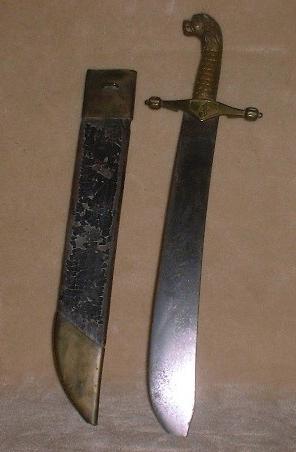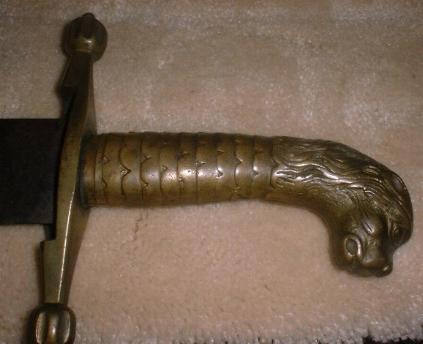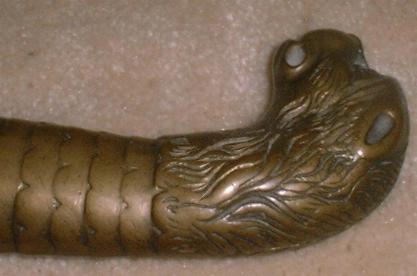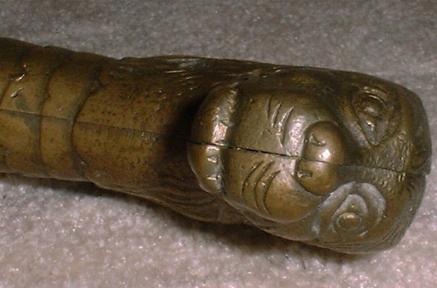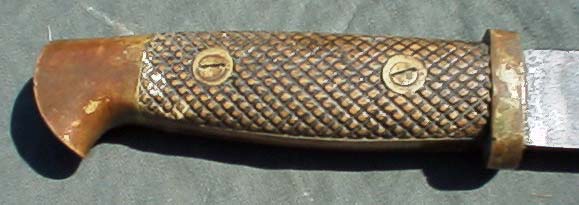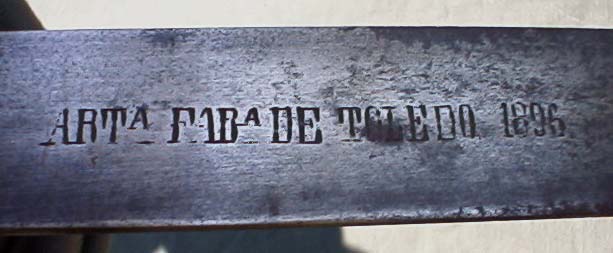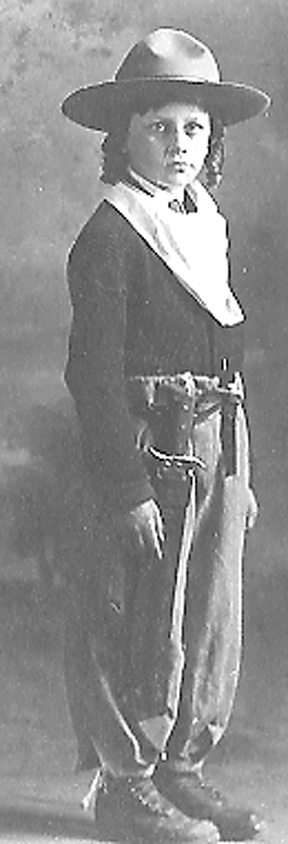

by Carter Rila
"El Cutachero"

Occasionally when attending an antique show or an arms show one will come across a sword-like edged weapon with a figured hilt. Among the most common have cast brass hilts with eagle pattern (aguila) heads; there is a wrist strap hole formed by the beak. The scales are wood or hard rubber and are usually checkered or cross-hatched. Often the brass frame has been nickeled. These armas blancas are found both with maker's marks o[sterling] European firms and with those of the famous Collins and Co. of Connecticut. Very often they are marked with the phrase "Machete Reglamentaro" and often with outfitter's marks -- a most common marking being La Catalana of Havana, Cuba.
This type of weapon is known in Central America as a cutacha and is so referred in the U.S. Marine Corps' Small Wars Manual of 1940. Several of them of various patterns purchased or captured during the Caribbean campaigns of the U. S. Marines have been donated by veterans to the U. S. Marine Corps Museum, Most of the ones found in the United States have the legendary attribution of being souviniered during the Spanish-American War. Numerous early Bannerman's catalogs show them in various patterns. Their sturdily constructed scabbards with buttons for belt frogs, metal throats, and tips with drags are of pure military style. It has been the expert conclusion for years that these weapons were likely government approved patterns; by whom and where and when has been unknown in this country until recently. The general type with its long straight blade has, however, not been limited to the use of Latin American military personnel; it has also been worn as a symbol of authority by important civilians such as plantation owners and overseers and by civil authorities such as policia and customeros.
In addition to the cast brass aguila pattern described above, the Collins Company made several civil varieties of the figured hilts. As shown in their catalog of 1919 these were the elephant's head ---el elephante, cock's head ---el gallo; the eagle head--el aguila (this is not the same pattern as described above) and the wolf's head --el lobo. in addition there ware also available various elaborately wire-wrapped hilts. The figured hilts are found with delicate inset glass eyes and have various scale materials. Because of their costly nature these implements though referred to in their catalog by Collins as machetes were not intended for cutting brush but were carried usually in a fine custom scabbard tied to the saddle. Alternatively they are of such a length that they are worn vertically with a belt frog.
Many such swords were made in Germany for export to Latin America and currently available reprints of old catalogs show many varieties; handsomely mounted, they all have guarded hilts and very plain long straight blades of a cross-section which is primarily rectangular with a chisel shaped fore edge. I have yet to see one with a decorated blade. The back is never edged in any manner. Think of a tall pole which comes to a point at the top. That is the cross section.
A moment's consideration will reveal that in no way can these swords be considered as true machetes functionally for their short straight grips and their long thick blades are not suited to the machete swing used by any true machetero to cut his way through cane field, crop, or jungle, Why then, are they called machetes and why did the most famous machete maker of all, Collins, once carry them as a standard item in their catalog?
We must now, pause for a moment in our inquiry and consider what is a true machete and how it is used? No matter what form, length or shape, in contrast to sword, cutlass, or saber, which have comparatively thick and stiff blades and are designed to be firmly gripped with the whole hand, a true machete has a wide, somewhat flexible and thin blade, and is made so that it can be swung, pivoting in the hand between the thumb and forefinger. Thus it accelerates and depends on its velocity not: its weight, for its cutting power. Contrast a razor blade to a chisel and you will get the idea exactly.
A machete slices through its target, not hacks through it; this is in contrast to a bolo, which does depend on hacking power. The '.'machete was designed for cutting the soft, herbaceous brush and plants of the Americas, and though recognizable brothers of the Latinoamericano's machete are found in Africa, the hard, bamboo growth of Asia and the Philippines will defeat a machete any time. In English-speaking African countries the preferred spelling is matchet. Pronounced --Ma . chet! for the t is silent. Of course a machete can be held tightly and used for chopping, and its cousins, the corn knife of North America and the cane knife of the Islands are so used.
True machetes are found in many lengths from 12 inches to over three feet and shapes from straight to curved to bulbous. In ail cases, and in contradiction to popular Norteamericano opinion, they are primarily tools, which at times may be pressed into service as weapons just as the medieval peasants carried their pikes and pitchforks to war. Some common machetes referred to in the literature and catalogs are:
Cutacha --- sword or fighting machete.
Machete de monte --- bush or jungle machete.
Machete cañero --- cane knife, short and stubby, and often found with a hook.
Machete costeño --- a long special pattern common to the west coast of Mexico which has a bulbous blade, sharpened on the fore edge for its full length, and on the back to half way up to the end of the bulge.
Most familiar to Norteamericanos is the machete de monte pattern; our present military standard machete, the 18 inch long blade M1942 is an excellent example. Though not perfect for ail uses, it suffices for most military uses, chief of which are trail cutting and camp mating. Contrary to popular belief, a machete is not considered a weapon, nor is it stocked as such but as a tool, and though it may be used as a weapon such use is incidental to its true purpose, an intrenching tool. l have covered all of tins elsewhere so on with our inquiry.
The Norteamericanos first encountered the machete during the period of the Spanish American War. General Frederick Funston in his memoirs stated:
All mounted officers and men carried the long or cavalry machete with a blade about two and one half feet in length... Dismounted troops carried in addition to their rifles, the short machete use mainly in time of peace in cutting cane and brush, (p 31-32)
As stated above it has long been known what the Machete Reglamen-tarios were, but until recent years there has been no documentation avail-able to me. This lack of information has been rectified by two books pub-lished in recent years on Spanish edged weapons.
Before proceeding we have to take another side step into the thicket of linguistics. We start with the assumption that the name of something is what the people who use it call it. Thus if in an area where the locals call what the world calls a hat a spoon, you must ask for a spoon if you need a hat. in th3.t area a hat is a spoon regardless of what it technically or scientifically -nay be. Thus, though we have observed that a cutacha is not technically a ..machete, if the people who use it call it that, so should we. On the other hand we should not make up a name just because we think it is appropriate or colorful, as so many do in edge collecting.
The second assumption is that there may be more than one perfectly valid and technically correct name for an object in various areas using the same language, or in those using different languages. In every language, there are subtle differences in terms which, even though they can be translated by the same foreign word, really connote differing things. The French language is noted for multiple words with subtle differences that cannot be translated into English without using qualifying phrases. Here's a good English examples of valid synonyms. "is it a bag, a sack, or a poke?"
So, to find cutacha, we must look in a Spanish dictionary a proper definition of cutacha, published in the Americas, and, even more to the point, one of the depth of Webster's International, or the Oxford English Dictionary, not some phrase book or traveler's handbook. These books must have been published in Spanish for Spanish speakers who will appreciate the subtleties concerned.
Here are some definitions of cutacha and related terms, gleaned from various sources.
Machetes in these countries are of two general types, one is for work and the other is for fighting. The working machete...is distinguished by its heavy weight, the blade being broader and slightly curved at the end away from the handle and without a guard ...The fighting machete or cutacha has a (guard) and is narrow, light, and s bar ?....( U.S. Marine Corps)
The following are from the original Spanish. The translations are mine.
cutacha f. Amer. cuchillo largo y recto = large straight knife (Larousse, p 299)
cutacha f. Am Central y Panama. Cuchillo o machete; es la cuma = knife or machete; it is a cuma. (Maleret, p 237)
cuma f. Am Central. Cuchillo grande o machete corvo con mango largo = large knife or curved machete with a big hilt. (ibid, p 282)
cuma f. //En Centroamerica, machete corto = short machete (UTEHA,Vol.III p 868)
cutacha f. En Centroamerica, cuchillo o machete = machete or knife (ibid, p 835)
machete m. [No point in copying all the Spanish this time.] Arm much shorter than a sword, it is wider, much heavier, and has a single edge = large knife of various forms which serves for clearing (brush), for cutting sugar cane, and for other uses// (ibid, Vol VII, p 25)
In view of all the foregoing, we should agree the sword-machete carried in Cuba, and the Central American countries is termed a cutacha by those who carry it.
On the other hand, tie persons who named the issue edged tools and weapons of the Spanish army were residents of the mother country so we must look to their dictionaries and other sources to determine what they meant when they named the items. Fortunately the arms books tell us what we want to know. Again, the translations are mine.
3. B. Barceló Rubí, writing in Spain, stated:
Machete - knife of large proportion which serves as either an arm or as a tool. Very useful for clearing the brush from the camp or the trail, it finds most use by the gunners, sappers, and infantry pioneers. in the over seas campaigns the machete is indispensable. Without it one cannot get through the tangled tropical vegetation. Observe the deadly effect of the same arm wielded with singular dexterity by the insurrectos. Some models have been constructed .so that they can serve as bayonets, (p 273)
Juan Sopena Garreta, another Spanish author, wrote in more detail:
The machete is defined as an edged weapon which besides serving to wound with the point or with the edge, is also employed as a tool. [Just the reverse of the U.S. Army definition.-C.R.]
It is an arm when in its origins, it was designed to be used by the troops who did not have to carry a firearm, as a sidearm, and, for whom also, the snort edged weapon served as a tool. For this reason, the first machetes were intended for artillery and pioneers, and much later, issued also to the rest of the army. But with the replacement of the diverse types of firearms, first by the Model 1857, and later by the adoption of the Remington breechloader, the machetes, also were "unified" and the first attempt at an (universal) design was the Model 1881 Machete, which attempted to make it feasible to attach the machete to the rifle. But this intent was not successful until the adoption of the Mauser. [I believe he is talking about the knife or cuchillo bayonet not a machete when he mentions attaching to a rifle. Imagine a three foot sword on the end of a four foot rifle-C.R.]
In 1892 by Royal Order of January 9 there was adopted as regulation by the Infantry of the Cuban Army, a typical machete as used on the island, which was designated Model 1891. This machete has a hilt similar to the Model 1881, but its, length is much longer and its continuous edge, much sharper, f~4)
Let's look closely at the Model 1891 Machete. Note that it was adopted for the Cuban Army only, not the Spanish possessions in tropical Africa where it might also have been useful. Rubí describes it as follows:
Machete Model 1891 for the Infantry of the Cuban Army With cutting edge only on the front and the back square. The blade is straight and its width increases almost inperceptably until at the place where the blade is widest, (there is) an abrupt change in direction to form the point. Two flats extend on each side along the blade. This describes a flat blade with a chisel edge and a slant point. -C.R.]
The hilt is similar to the Model 1881 Machete although with brass ornamentation and has a shorter grip. The scabbard is leather, with fittings of brass. The throat has a fastener (loop) along its length (vertically) . It also has a button. The tip is of constant width and rounded at the end, reinforced by a narrow vertical (sic) piece. [A drag.-C.R.]
Some selected dimensions -
Blade length 637 mm Hilt length 144 mm
Blade max. width 33 mm Guard length 107 mm
Blade width at hilt 31 mm Scabbard length 649 mm
Various data
This machete was not declared regulation until 1892 (Royal Order 9 Jan) thus giving reason for some to call it Model 1892. (Bb 49-2)
The data in the preceding table was taken from the Plates of War Material (Bb 26-8) which were published in No. 33, Series E. The production plan of 1895 included 924 units at the price of 18.50 pesetas. (133, 134)
Judging from the above production figures this item was not intended for issue to every rank and file soldier in the Cuban Infantry. Perhaps it was for NCOS and worn as a badge of office. Certainly the chisel edge indicates this very well. The 1891 model has a hilt with set in grip scales like unto a bayonet not the aguila hilt as typical of officer's cutachas.
Garreta in his work describes the Model 1891 machete as follows:
Name Machete for the Infantry of the Army of Cuba, Model 1891 Characteristics Total length 781 mm
Blade length 637 mm
Hilt length 125 mm
Width 33 mm
Declared regulation by Royal Decree of 9 Jan 1892 for the Infantry of the Army of Cuba.
Description 1.The blade. It is straight and long. The edge is continuous on the anterior and is very sharp. The back is square on the posterior.
2. The hilt. It is similar to the Machete Model 1881.
3. The scabbard. It is of leather, with mouthpiece an3 tip of brass. On the throat is attached an extended loop. frog.-C.R.] The tip is similarly fastened on its whole length, stayed and finished by a narrow jamb (reinforce). [a drag-C.R. (40,41)
Garreta goes on to discuss various special purpose arms which do not fit in his previously covered categories. 'The special purpose arms include naval boarding arms and various machetes. One of the latter is the cutacha or sward-machete--the primary subject of this essay.
Model for Overseas.
Name Machete for the Army of Cuba
Characteristics Total length 840 mm
Blade length 703 mm
Hilt length 140 mm
Width 34 mm
This machete adopted by the Army of Cuba, [Note the difference. This was not adopted by Royal Decree but by the Cuban Army itself.-C.R.] is found in various versions. One of these distinctions is in the material used for the hilt. Some are of brass and others of ebony wood. Another version with a difference in length is much narrower and ends in a point. [The illustration shows the slant point.-C.R.]
On the metal hilted ones, some of the marks found are:
FERD.ESSER, ELBER-FELD and MACHETE REGLAMENTARO. On others is stamped the latter and in an oval LA CATALANA/ TENIENTE REY-26/ HABANA/.
The last mentioned "Cuban Army Machete" is the pattern which I have seen the most of; I own several. The cast brass hilts are all of the same style and could almost be from the same molds even though some were made in the U.S. by Collins and some were made by various makers in Germany. Garreta's Plate 12 shows this exact same aguila hilt as is found on Machete Reglamentario" marked cutachas.
On the other hand the Model 1891 hilt resembles most closely a bayonet hilt and has molded hard rubber grips. All of the aguila hilts nave the hard rubber grips. The hilts all measure 135 mm on center line. Some have molded grooves and some have had the grooves cut into them after assembly as the rivets are also grooved in the same manner. Though the blades are of varying length they average about 572 mm long and ail are exactly 30 mm wide with no taper in width. However they do taper from the hilt to the point in thickness and have a spear point and a rolled or tapered edge not the chisel edge of the Model1891 and the Machete para Ultramar as shown by Garreta and Rubí. Those which do not have a spear point have a rounded point with a straight back. The opposite configuration from that of a sheep's-foot blade.
The European made commercial versions are marked with No. 87 or No. 877 depending on the maker. The 377 number was a subterfuge to avoid using the Collins Company's pattern number no. 87 for this blade configuration. The Collins number for the spear point was 86. These numbers refer only to the blade shape in Collins usage. The orderer also Had to specify the length, finish, and the hilt and anything else specially wanted.
The marking in an oval of LA CATALANA, etc. was the outfitter's markings. La Catalana was the same sort of company as Lilley-Ames or Schuyler, Hartley, and Graham in the United States.
I state my conclusions. The special pattern of cutacha adopted for the use of the Army of Cuba under the Spanish rule was marked as "Machete Reglamentario" even though it was not a true machete but a sword.
It was related in function to the short swords issued for many years by the Spanish, French, and others including the U.S. to the gunners. With the issue of revolving pistols to gunners in our Civil War the Artillery Short Sword become obsolete as a weapon and as a tool for in North American terrain when a cutting tool was needed an ax was more useful in cutting trees.
Another indication that they were for use only by officers is that, in addition to not being truly suited to whacking brush, for their chisel edges can not be well-sharpened, is their relative scarcity, for if they had been for general use, there would be many more of them around, Most of them do show some wear from carrying but by and large they have never been sharpened, the nickel plate is intact, and they are not the machete de monte one would choose to wield all day in the bush.
On the other hand, contemporary photos, documents, and accounts state that the foot soldier did carry some sort of machete de monte most of the time, though whether they were issued is not known. A most popular pattern with- both insurrectos and regulares was the long slender Collins No. 22 pattern, or an equivalent pattern by other makers. These were the mounted patterns referred in General Funston's account. The U.S Ordnance Department during the Spanish American War issued some Collins No. 22 patterns with horn grips to the U.S soldiers. These proved unwieldy for foot troop use and were soon withdrawn. Later the shorter Collins machete de monte patterns 127 and 37 were procured for troop use.
(c)Carter Rila 2001

Collins & Co. Catalogo Illustrado , 17th Ed. (1919)
"Collins Co., Collinsville, Conn." Fortune Vol. 33:1 Dee 1945
Diccionario Encyclopedia UTEHA (Union Tipographica Editorial Hispano-Amécicana, Mexico, 1953)
Frederick Funston, Memories of Two Wars (Scribner's, 1914)
Juan Sopeno Garreta, Historia del Armamento Español, vol VI, las Ar.Tias
Blancas, II, 1700-1977. [History of Spanish Armaments, Vol.VI, Edged
Weapons, II. .] (Talleres Grafico Ly E.S.A., 1978)
Auqusto Maleret, Diccionario des Americanismos (Esecé Editores, S. A.
Buenos Aires, 1946)
Pegueño Illustrado Larousse (Larousse, Paris, 1978)
3. Barceló Rubí, El Armamento Portatil Espanol (1764-1939) una Labor
Artilleria [Spanish Small Arms, 1764-1939, an Armorer's Work] (Libreria
Editorial San Martin, Madrid, c 1976)
U. S. Marine Corps Small Wars Manual (GPO, 1940) Chap. II. para. 2

Examples and illustrations:
